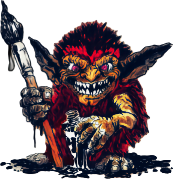Urban Rubble Bases
Created by: Monkphin
This is how I create my 'sandstone' style urban rubble bases. While the pictured base is a mix of mud and stone it can be applied to more urbanised environments easily enough, just focus more on the stone sections and miss the mud parts where needed. Similarly the reverse is also true, if you want more mud than stone focus more on the mud aspect of the recipe. I use a mix of cork, slate and other bits to build out the base, as well as texture paints such as AKs Muddy Ground, or Citadels Stirland Mud. Other paints used include: Black Primer (AK Interactive) Chocolate 70.872 (Vallejo) Fur Brown (Army Painter ) Balor Brown (Citadel) Zandri Dust(Citadel) Ushabti Bone (Citadel) Skeleton Horde (Citadel) Contrast Medium (Citadel) Agrax Earthshade (Citadel) White 70-951 (Vallejo)
No paints listed for this stage. No paints listed for this stage. No paints listed for this stage. No paints listed for this stage. No paints listed for this stage. No paints listed for this stage. No paints listed for this stage. No paints listed for this stage. No paints listed for this stage. No paints listed for this stage. No paints listed for this stage.-
Stage: 1 None
-
Stage: 2 None
-
Stage: 3 NoneNo paints listed for this stage.
So this will vary depending on the part of the base being painted. Initially, we'll just focus on the ground/Mud effects, since some of the other stages use the same colours for the mud and the the stones/rocks. Start with a dry brush of Vallejo Chocolate, just focusing on the texture paint area of the base. Don't worry if some black still shows, this works for natural shading.
-
Stage: 4 None
-
Stage: 5 NoneNo paints listed for this stage.
Next up is Balor Brown. This is applied to both the mud effects and stone areas. Again with a dry brush, with most of the paint removed, drybrush the entire base. The stone areas should pick up a lot of the paint, the mud areas less so.
-
Stage: 6 NoneNo paints listed for this stage.
Next up, just focusing on the stones for a moment. Once the last layer is dry, we add a lightish dry brush of Zandri Dust. We don't want full coverage, since the Balor Brown should still be visible in the recesses. But don't worry if you slip up, nature isn't perfect.
-
Stage: 7 NoneNo paints listed for this stage.
Again, we switch back to the entire base, this time with Ushabti Bone. Same as before, we lightly drybrush the mud/stone areas, using this as a method of highlighting what we've done before and acting to unify the two surfaces a little.
-
Stage: 8 None
-
Stage: 9 NoneNo paints listed for this stage.
Back to the stones.. First up mix up a small amount of Contrast Medium and Skeleton Horde, ideally around 1:1 is fine. Once this is mixed, apply it liberally to the stones, going for an all over coverage. This just adds a bit of depth and helps tie in the previous stages.
-
Stage: 10 NoneNo paints listed for this stage.
And onto the white - this is to be used sparingly, just adding slight striations here and there to the stone, or perhaps very slight and infrequent edge highlights. The idea is to break up the uniformity a little and make the rock look more organic.
-
Stage: 11 NoneNo paints listed for this stage.
Finally, we're on clean up and bonus work. Here we just need to clean the trim of the base - Black for me, but whatever colour you like will work fine. And if you fancy it, adding things like static grass, or other effects like moss etc can help make things really pop.






















